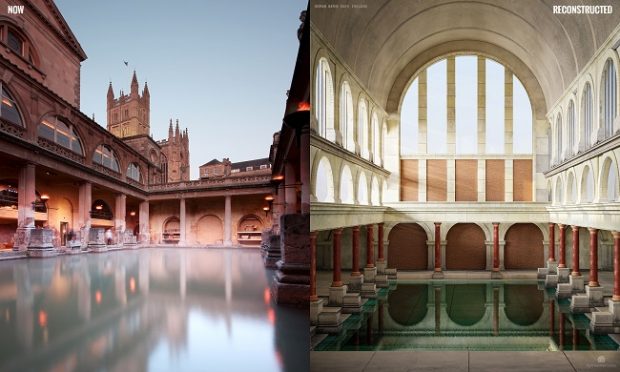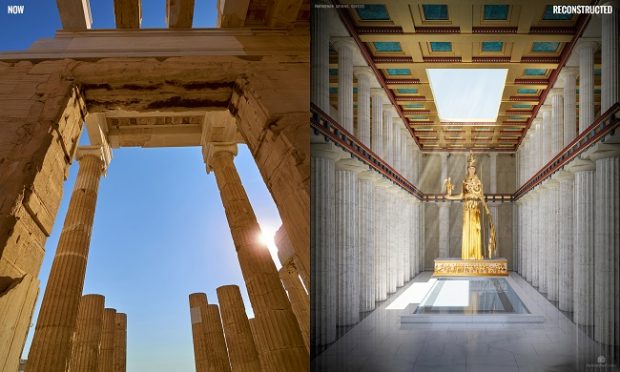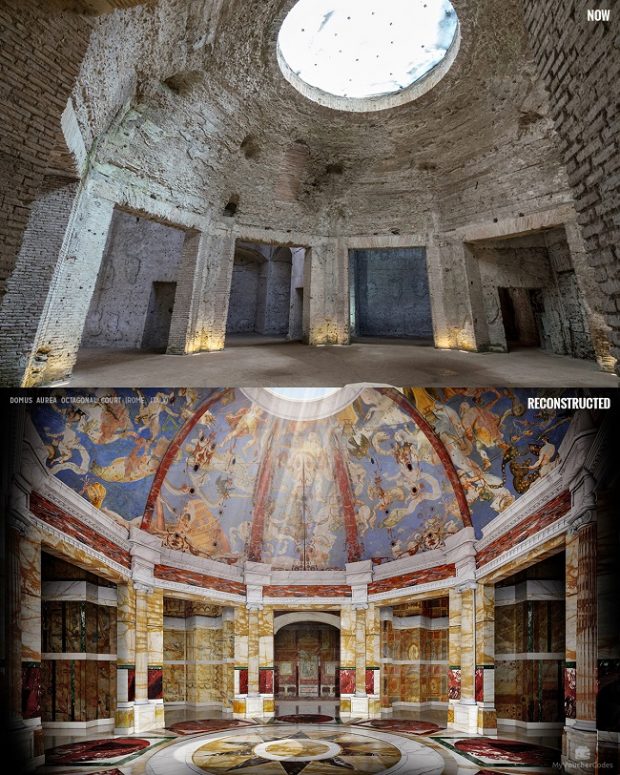When you’re a kid, history lessons often mean learning an uninspiring series of dates and events. It’s only when you get outside for the occasional field trip that the past comes to life. As grown-ups, most people don’t need to bother with the dry old facts. Instead, a good, warts-and-all history book and the freedom to visit astonishing places from our past add layers to our experience of the world around us. It can be dizzying to imagine human life taking place along the same paths you now tread, hundreds or thousands of years ago!
But sometimes you need a bit of help to flesh out the bare bones of a historical ruin. With that in mind, this series of revealing images has been created to visualize how some famous historical sites may have looked in their full glory.
Which will you visit first?
Roman Baths (Bath, England)
You might not be able to bathe in the Roman bathing complexes of Bath, but there are still plenty of places you can take a thermal spa after being inspired by the ruins. The original bathhouse complex is nearly 2000 years old. But the things that went on there are timeless! Westerners still love to meet, gossip, and relax together, but we’ve mostly lost the initiative to do so in a bubbling hot natural spring – as those decadent ancient Romans liked to do.

The remaining pillars and pool hint at the grandeur our ancestors enjoyed, but the reconstruction adds the color and the roof that are missing today.
Parthenon (Athens, Greece)
Older still, the mid-5th century BCE temple at the Acropolis was every bit the status symbol in its time as it is today. While visitors to modern Greece will find themselves in awe of the iconic ruins, the original Parthenon was grander than you might imagine. It housed a 12-meter ivory and gold statue of Athena, designed not just for worship but as a signal of Greece’s wealth and power.

The statue was later moved to Constantinople by the Byzantines, and today nobody knows where – or if – it exists. As you can see, it must have been breathtaking when Athena still stood where she belonged.
Domus Aurea Octagonal Court (Rome, Italy)
The ‘Golden House of Nero’ is not so golden today. All the same, a visit to its warren-like remains is inspiring in itself. It becomes all the more so when you imagine how it used to look. The concrete-domed, octagonal banqueting room is said to have been richly decorated with gems, ivory, mother-of-pearl, flowers, and perfumes.

If that’s not bling enough for you, the room also boasted a revolving ceiling. But all this showiness looked a bit over the top once Nero died – so his successors had the room stripped.
Lower Terrace, Masada (Masada, Israel)
The fortress of Masada was built as a living space for Herod the Great between 37 and 31 BCE. Of course, his cherished view out over the Dead Sea remains in place today.
Much of the building, including the walls and their multi-colored frescos, has since crumbled – but it remains an enchanting place to walk and imagine what came before.
Great Kiva, Aztec Ruins National Monument (New Mexico, USA)
A more mysterious ruin, the Great Kiva of the Aztec people wasn’t re-discovered until 1859. It’s not surprising it took so long. We know very little about the Aztecs, and the kiva was built partly underground.
We do know that the space was used as a social hub: for meeting and banqueting. Today, you can take a walk through the area, which is preserved as part of the National Park Service, and even boasts some ‘real life’ reconstructions of its own.
Basilica of Maxentius (Rome, Italy)
Those Romans sure got about. But here’s one from their home turf: a meeting house and administration center in the Forum Romanum. And just because its purpose was more business-like than some of the other reconstructions, doesn’t mean it was any less beautiful.
Bronze walls, Corinthian columns, and multi-colored marble floors let visitors know that in Rome, business was booming.
Angkor Wat (Siem Reap, Cambodia)
The world’s largest religious monument took 30 years to build – and nine centuries later it remains on the ‘bucket list’ of today’s most serious travelers! Originally a Hindu, and then a Buddhist, temple, Angkor Wat is a blissful place to walk and reflect.
Like the dinosaurs before it, nobody quite knows what color Angkor Wat was – just that it was colorful. All the same, experts have made their best estimates, and it must have been even more astonishing before time took its toll.
Which ancient ruin would you like to see restored to its former glory?
Author bio: G. John Cole
John writes on behalf of NeoMam Studios. A digital nomad specializing in leadership, digital media, and personal growth topics, his passions include world cinema and biscuits. A native Englishman, he is always on the move, but can most commonly be spotted in the UK, Norway, and the Balkans.
LinkedIn: https://www.linkedin.com/in/gjohncole
Twitter: https://twitter.com/gjohncole
Gravatar: https://en.gravatar.com/gjohncole
